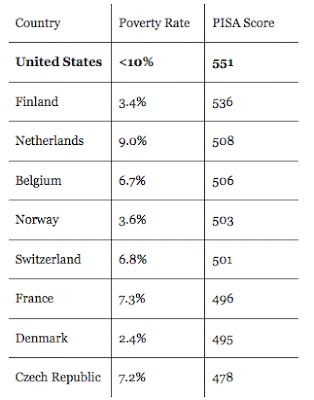We all know the stories bemoaning the test ranking of U.S. students compared to their peers around the world. But a key factor that's omitted from all such stories is the lack of comparability among the students being tested in terms of poverty.
If you compare subsets of U.S. students' test scores with those of students from countries with similar poverty levels, the U.S. students outperform the best around the world. Using the percent of students eligible for free and reduced-price meals as a measure of poverty, here's how the results come out:
(Note: South Korea does not report its poverty level. Its average PISA score is 539.)
As blogger Mel Riddle at the The Principal Difference put it:
Researchers report that perhaps the only true linear relationship in the social sciences is the relationship between poverty and student performance. While there is no relationship between poverty and ability, the relationship between poverty and achievement is almost foolproof....Given the increasing disparities in American income and wealth, does it seem likely the "problem" with our schools will be solved any time soon?
When I met with [Secretary of Education Arne] Duncan, I asked him if he had read the book or seen the movie, Blind Side. He indicated that he had and that he had enjoyed it very much. I reminded him of the pride and sense of accomplishment felt by the teachers in the private school attended by Michael Oher. In their minds, they had performed a miracle. I pointed out that, in high-poverty schools, a Michael Oher is the average student. In schools like ours we have hundreds of students like Michael Oher who depend on our school for everything including food, clothing, and emotional support.
via the wonderful @DianeRavitch
______
U.S. teen birth rates have hit their lowest point since recordkeeping began in 1940. What year was the peak rate? Like me, perhaps you would guess some time in the 1980s, maybe the 1990s.
Nope. It was 1957.



2 comments:
These are interesting numbers. Putting poverty in the mix changes everything.
Wow--did not expect that. But on reflection I guess it makes sense as birth control was not part of public or private conversations then, not even in the sixties when I was a teen.
Thanks again for finding and sharing such good stuff. And a belated Happy Anniversary.
Post a Comment